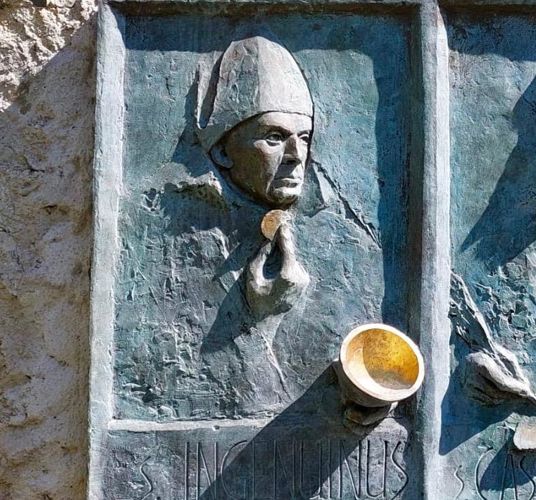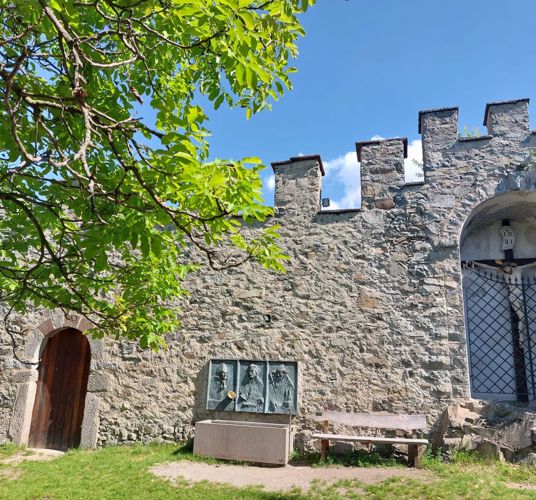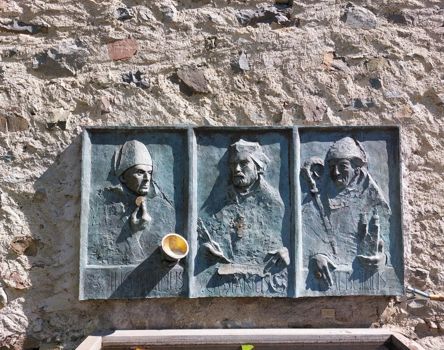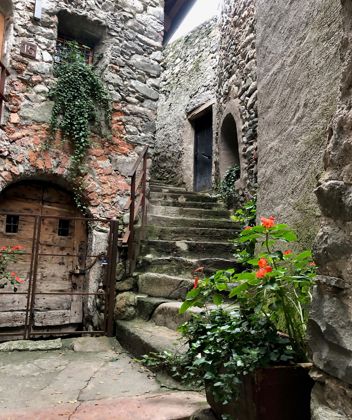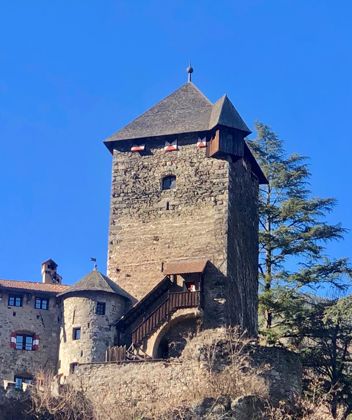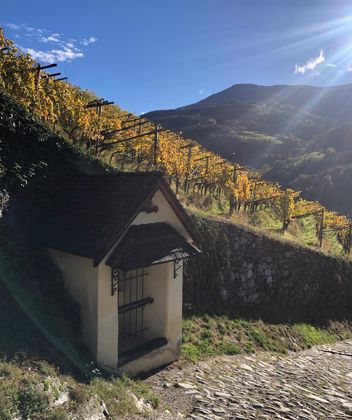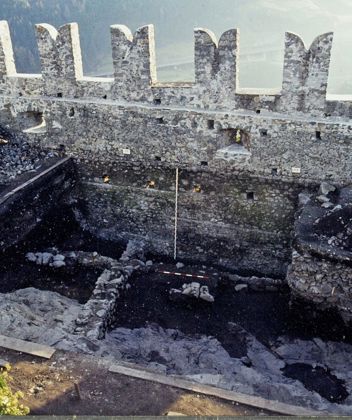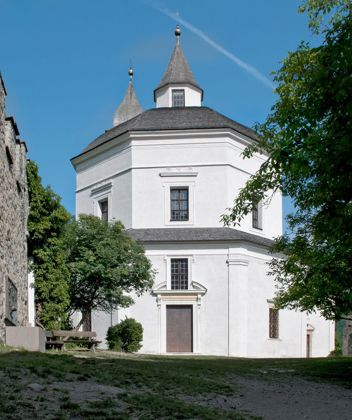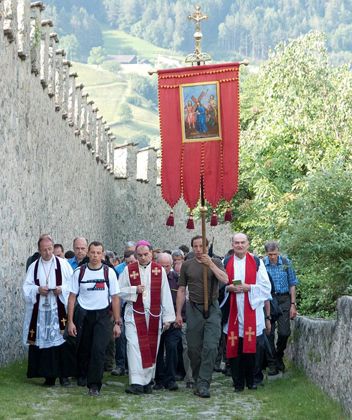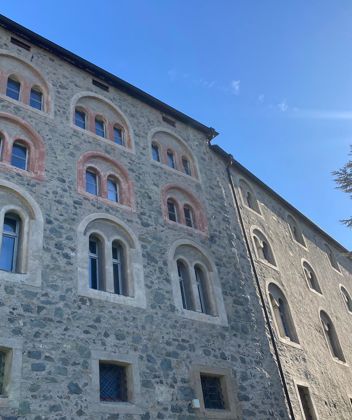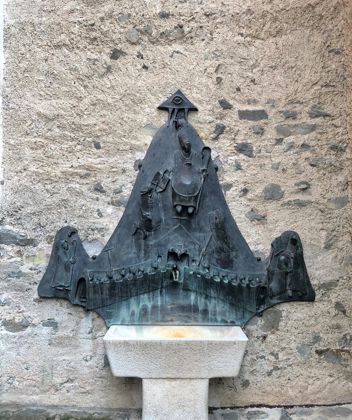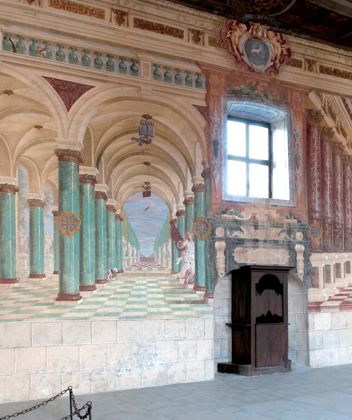To read along
06 The bishops’ fountain
Säben served as an episcopal see for almost half a millennium, with 27 bishops holding office in the period between 550 and 1000.
Above the bishop’s fountain is a relief by the South Tyrolean artist Werner Kofler from Neumarkt. It shows three of the 27 bishops. In the middle is Cassianus, on the left is Ingenuin and on the right is Albuin: these three personalities are regarded as saints and patrons of the Diocese of Säben and, subsequently, of the Diocese of Brixen.
Ingenuin is historically documented: he probably served as bishop from 577 to 605 and was an important theologian of his time, as indicated by the host and the chalice.
Cassianus appears in the centre: he is venerated as the founder of the Diocese of Säben. According to legend, he came from Imola near Bologna and died around 365. The word “Evangelium (Gospel)” symbolises his activity as a bringer of faith to our land.
Albuin is depicted on the right: also historically documented, he was bishop from 977 to 1007. In the relief he holds in his hand a model of Brixen Cathedral. Under Bishop Albuin, the episcopal see was moved from Säben to Brixen circa 990.
Archaeological excavations have shown that the episcopal see was originally located in the area of the Säben shrine to the Virgin Mary. In addition to an early Christian baptismal font, a church in the vineyard, remains of a settlement and the centre of an extensive burial ground have all come to light here: this evidence dates back to around 400 AD.
Since the bishop’s castle was later situated on the top of Säben mountain, there must at some time in the past have been a shift from below to above. It is difficult to pinpoint this in time, but it is often assumed that it may have occurred around the time of Bishop Ingenuin circa 600.
The castle fulfilled its function as a bishop’s residence until shortly before the year 1000, when Bishop Albuin moved the episcopal see from Säben to Brixen. The castle later became the seat of a castle governor: rebuilding over the centuries has greatly altered its structure.
Two events subsequently sealed the history of the bishop’s castle: 1533 was a fateful year, when a lightning strike caused a devastating fire that turned the castle into a ruin. The monastery was built 150 years later, with the new buildings built on the ruins. As a result, hardly anything of the former castle can be seen today: only a few bricked-up bifora windows have survived on the attic storey. A year (incomplete) and the coats of arms of Brixen and of Bishop Melchior von Meckau are clearly visible above the lower monastery gate.
Above the bishop’s fountain is a relief by the South Tyrolean artist Werner Kofler from Neumarkt. It shows three of the 27 bishops. In the middle is Cassianus, on the left is Ingenuin and on the right is Albuin: these three personalities are regarded as saints and patrons of the Diocese of Säben and, subsequently, of the Diocese of Brixen.
Ingenuin is historically documented: he probably served as bishop from 577 to 605 and was an important theologian of his time, as indicated by the host and the chalice.
Cassianus appears in the centre: he is venerated as the founder of the Diocese of Säben. According to legend, he came from Imola near Bologna and died around 365. The word “Evangelium (Gospel)” symbolises his activity as a bringer of faith to our land.
Albuin is depicted on the right: also historically documented, he was bishop from 977 to 1007. In the relief he holds in his hand a model of Brixen Cathedral. Under Bishop Albuin, the episcopal see was moved from Säben to Brixen circa 990.
Archaeological excavations have shown that the episcopal see was originally located in the area of the Säben shrine to the Virgin Mary. In addition to an early Christian baptismal font, a church in the vineyard, remains of a settlement and the centre of an extensive burial ground have all come to light here: this evidence dates back to around 400 AD.
Since the bishop’s castle was later situated on the top of Säben mountain, there must at some time in the past have been a shift from below to above. It is difficult to pinpoint this in time, but it is often assumed that it may have occurred around the time of Bishop Ingenuin circa 600.
The castle fulfilled its function as a bishop’s residence until shortly before the year 1000, when Bishop Albuin moved the episcopal see from Säben to Brixen. The castle later became the seat of a castle governor: rebuilding over the centuries has greatly altered its structure.
Two events subsequently sealed the history of the bishop’s castle: 1533 was a fateful year, when a lightning strike caused a devastating fire that turned the castle into a ruin. The monastery was built 150 years later, with the new buildings built on the ruins. As a result, hardly anything of the former castle can be seen today: only a few bricked-up bifora windows have survived on the attic storey. A year (incomplete) and the coats of arms of Brixen and of Bishop Melchior von Meckau are clearly visible above the lower monastery gate.

